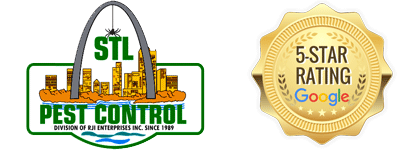Those bushy-tailed grey squirrels scampering through your St. Louis yard might seem charming, but beneath their playful exterior lies a potential for significant and costly damage to your home and property. While they’re a natural part of our local ecosystem, when these persistent rodents decide your house offers the perfect shelter, they can quickly turn from a backyard delight into a serious pest problem.
At STL Pest Control, we understand the unique challenges St. Louis homeowners face with wildlife, including the often-underestimated grey squirrel. Let’s explore the various ways these seemingly harmless creatures can wreak havoc on your lawn, roof, attic, and more.
The Ground Attack: Damage to Your St. Louis Lawn and Garden
Grey squirrels are notorious for their “scatter-hoarding” behavior, burying nuts and seeds throughout your yard. While this might seem benign, it can lead to:
-
Holes and Uprooted Plants: Their constant digging can leave your pristine lawn pockmarked with small holes, and they’ll readily dig up freshly planted bulbs, seeds, and even young plants in your garden.
-
Damaged Produce: If you’re growing fruits, vegetables, or even just some pretty flowers, squirrels can quickly become an unwelcome harvest crew, munching on your hard work before you get a chance to enjoy it.
-
Tree and Shrub Damage: Squirrels may strip bark from trees and branches, especially younger ones, which can weaken or even kill the plant over time.
The Roof Rascals: Threats to Your St. Louis Roofline
Your roof, with its many entry points, is a prime target for squirrels seeking shelter. They can cause damage in several ways:
-
Chewed Soffits, Fascia, and Vents: Squirrels have incredibly strong, constantly growing teeth, and they will gnaw through wood, aluminum, vinyl, and even lead vent pipes to gain access to your attic or wall voids. This creates vulnerable openings for water intrusion and other pests.
-
Damaged Shingles: Their persistent chewing can even pierce through shingles, leading to leaks and eventual water damage to the underlying structure.
-
Clogged Gutters: Squirrels are known to build nests in gutters, impeding proper drainage and causing water to back up and overflow, potentially leading to siding and foundation damage.
The Attic Invasion: The Most Destructive Scenario
When squirrels gain access to your attic, the real trouble begins. Your attic provides a warm, dry, and secluded environment, making it an ideal nesting site, especially during colder months or for raising young. The damage they inflict here can be extensive and dangerous:
-
Chewed Electrical Wires: This is arguably the most significant hazard. Squirrels chew on electrical wiring to keep their teeth filed down, exposing live wires. This creates a serious fire risk, accounting for a significant number of house fires annually.
-
Destroyed Insulation: Squirrels will tear, compact, and contaminate your insulation with urine and feces to create nests. This not only reduces your home’s energy efficiency, leading to higher utility bills, but also creates a biohazard.
-
Structural Damage: They’ll gnaw on wooden beams, rafters, and other structural components, weakening the integrity of your home over time.
-
Foul Odors and Health Risks: Accumulation of squirrel droppings and urine can lead to pervasive, unpleasant odors that permeate your home. Furthermore, squirrels can carry diseases like leptospirosis and tularemia, and they often bring fleas and ticks into your living space, posing additional health risks.
-
Noise Pollution: The constant scratching, scurrying, and gnawing noises from your attic can be incredibly disruptive, especially in the early mornings and late afternoons when squirrels are most active.
Signs You Have a Squirrel Problem
Beyond seeing the squirrels themselves, here are some tell-tale signs they’ve made your St. Louis home their own:
-
Unusual noises: Scurrying, scratching, or gnawing sounds coming from your attic, walls, or ceiling, particularly at dawn and dusk.
-
Visible damage: Chewed holes in your roofline, soffits, fascia, or vents. Gnaw marks on electrical wires, wood, or stored items in your attic.
-
Droppings and urine stains: Small, cylindrical droppings (like dark brown jelly beans) and amber-colored urine stains in your attic or near entry points.
-
Nesting materials: Piles of shredded insulation, leaves, twigs, and other debris in your attic.
-
Increased squirrel activity: Observing squirrels repeatedly entering or exiting the same spot on your roof or exterior.
-
Foul odors: A strong, musky, or ammonia-like smell, potentially from urine or dead squirrels.
Don’t Let Cute Become Catastrophe – Call STL Pest Control!
If you suspect grey squirrels have taken up residence in your St. Louis home, it’s crucial to act quickly and call the professionals. Attempting DIY squirrel removal can be dangerous, as squirrels can bite or attack if cornered, especially if young are present. Moreover, without proper knowledge and equipment, you risk trapping squirrels inside your home, leading to further damage as they try to escape.
At STL Pest Control, our experienced and licensed technicians specialize in humane squirrel removal and control. We will:
-
Conduct a thorough inspection: Identify entry points, assess the extent of the infestation, and pinpoint all areas of damage.
-
Safely and humanely remove squirrels: Using proven techniques like live trapping and exclusion methods, we ensure the squirrels are safely removed from your property.
-
Prevent future infestations: Seal off all entry points with durable, squirrel-proof materials to ensure they can’t get back in. We can also advise on tree trimming and other preventative measures.
-
Repair and remediate damage: Recommend and assist with necessary repairs to damaged areas, including insulation replacement and attic clean-up, to restore your home’s integrity and safety.
Don’t let these “cute” critters turn into a costly nightmare. Contact STL Pest Control today for a free inspection and reclaim your St. Louis home from unwanted guests! We’re here to provide effective, long-lasting solutions for all your pest control needs.

